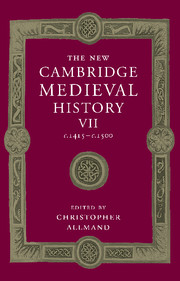Book contents
- Frontmatter
- PART I GOVERNMENT
- PART II ECONOMIC AND SOCIAL DEVELOPMENTS
- PART III SPIRITUAL, CULTURAL AND ARTISTIC LIFE
- PART IV THE DEVELOPMENT OF EUROPEAN STATES
- 17 Germany and the Empire
- 18 Hus, the Hussites and Bohemia
- 19 France
- 20 Burgundy
- 21 England
- 22 The Celtic world
- 23 Italy
- 24 The Iberian peninsula
- (a) Aragon
- (b) Castile and Navarre
- (c) Portugal
- 25 The Swiss Confederation
- 26 The States of Scandinavia, c. 1390– c. 1536
- 27 Hungary: Crown and Estates
- 28 The Kingdom of Poland and the Grand Duchy of Lithuania, 1370–1506
- 29 Russia
- 30 Byzantium: The Roman Orthodox World, 1393–1492
- 31 The Latin East
- 32 The Ottoman World
- 33 Conclusion
- Appendix Genealogical Tables
- Primary Sources and Secondary Works Arranged by Chapter
- Index
- Frontispiece
- Plate section
- Map 1 European towns in the late Middle Ages
- Map 2 European commerce and trade
- Map 4 Winds and currents facilitating the discoveries
- Map 5 The universities o f Europe in 1400 and 1500
- Map 6 Germany and the Empire
- Map 20 The Roman Orthodox and Ottoman worlds in the fifteenth century
- References
(a) - Aragon
from 24 - The Iberian peninsula
Published online by Cambridge University Press: 28 March 2008
- Frontmatter
- PART I GOVERNMENT
- PART II ECONOMIC AND SOCIAL DEVELOPMENTS
- PART III SPIRITUAL, CULTURAL AND ARTISTIC LIFE
- PART IV THE DEVELOPMENT OF EUROPEAN STATES
- 17 Germany and the Empire
- 18 Hus, the Hussites and Bohemia
- 19 France
- 20 Burgundy
- 21 England
- 22 The Celtic world
- 23 Italy
- 24 The Iberian peninsula
- (a) Aragon
- (b) Castile and Navarre
- (c) Portugal
- 25 The Swiss Confederation
- 26 The States of Scandinavia, c. 1390– c. 1536
- 27 Hungary: Crown and Estates
- 28 The Kingdom of Poland and the Grand Duchy of Lithuania, 1370–1506
- 29 Russia
- 30 Byzantium: The Roman Orthodox World, 1393–1492
- 31 The Latin East
- 32 The Ottoman World
- 33 Conclusion
- Appendix Genealogical Tables
- Primary Sources and Secondary Works Arranged by Chapter
- Index
- Frontispiece
- Plate section
- Map 1 European towns in the late Middle Ages
- Map 2 European commerce and trade
- Map 4 Winds and currents facilitating the discoveries
- Map 5 The universities o f Europe in 1400 and 1500
- Map 6 Germany and the Empire
- Map 20 The Roman Orthodox and Ottoman worlds in the fifteenth century
- References
Summary
the compromise of caspe
The death of King Martí (31 May 1410) led to a crisis within the states of the crown of Aragon. It was resolved in a radical fashion which has been the cause of debate ever since. Martí’s death brought to an end the dynasty founded with the marriage of the infanta Petronilla of Aragon to Ramon Berenguer, count of Barcelona, which had reigned uninterruptedly since 1137. The demise of the line was caused by Martí’s lack of legitimate heirs, after the death of his son, Martí (July 1409), during the military campaign in Sardinia, although, through Martí, the king did have an illegitimate grandson, the young Frederic, count of Luna. Martí I’s fondness for Frederic did not blind him to the problem of his illegitimacy, especially since there were other claimants to the crown whose rights were beyond dispute. The strongest of these was Jaume, count of Urgel, who had been appointed first lieutenant and later governor-general by the king himself, who thus almost appeared to be naming him his heir, giving rise to constitutional questions among the Aragonese. On his father’s side, Urgel was descended from a junior line of the family of Alfons IV ‘the Benign’. A member of the powerful Catalan family, he was disliked by the minor aristocracy and was strongly opposed by the patrician class of Barcelona. Louis of Anjou, duke of Calabria, and Fernando ‘de Antequera’, the infante of Castile, were more closely related to Martí, but through the maternal line, Violante, the mother of Louis, being the daughter of King Joan I, Martí’s elder brother and his immediate predecessor, while Fernando’s mother, Elionor, was Martí’s sister and wife of Juan I of Castile.
Keywords
- Type
- Chapter
- Information
- The New Cambridge Medieval History , pp. 588 - 605Publisher: Cambridge University PressPrint publication year: 1998

